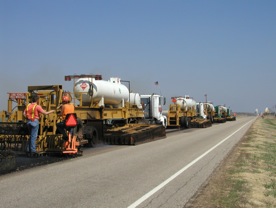 What: Hot In-Place recycling is a continuous process with self-contained train of equipment that heats the distressed surface to 250-300°F, scarifies or mills it to a depth of 3/4-2”, mixes it with new, rejuvenating asphalt binder, lays the recycled mix with a paver, and compacts the mat in readiness for new surfacing as dictated by the traffic and road conditions. The new binder may be emulsified asphalt; it may have rejuvenator oils, polymers or other additives to improve the existing binder. There are three types of HIR: surface recycling, repaving, and remixing. Surface recycling is as described–a new surface may be applied as part of the process or later. Repaving combines the HIR with a simultaneous overlay of a new hot mix asphalt (HMA) to form a thermal bond between the new and recycled layers. Remixing involves collecting the milled material into a windrow, mixing of the material with virgin aggregates and recycling agents (and new HMA, if required) in a pugmill, and laying of the recycled mix as a single, homogeneous mix.
What: Hot In-Place recycling is a continuous process with self-contained train of equipment that heats the distressed surface to 250-300°F, scarifies or mills it to a depth of 3/4-2”, mixes it with new, rejuvenating asphalt binder, lays the recycled mix with a paver, and compacts the mat in readiness for new surfacing as dictated by the traffic and road conditions. The new binder may be emulsified asphalt; it may have rejuvenator oils, polymers or other additives to improve the existing binder. There are three types of HIR: surface recycling, repaving, and remixing. Surface recycling is as described–a new surface may be applied as part of the process or later. Repaving combines the HIR with a simultaneous overlay of a new hot mix asphalt (HMA) to form a thermal bond between the new and recycled layers. Remixing involves collecting the milled material into a windrow, mixing of the material with virgin aggregates and recycling agents (and new HMA, if required) in a pugmill, and laying of the recycled mix as a single, homogeneous mix.
Where: HIR should be used on structurally sound pavements with good drainage but distressed surfaces. HIR has been successfully done on all types of roads, from city streets to rural roads to interstate highways. Before HIR, the reasons for the distresses should be analyzed so they can be corrected by the HIR process.
Why (advantages): Aged, distressed surfaces are replaced with new surfaces in a cost-effective process. HIR levels deformations, removes surface cracking, re-establishes crowns, maintains clearances and curb heights, and reuses existing materials. The construction is quick, with immediate traffic return. The recycled pavement can be higher quality than the original, with rejuvenator oils restoring the chemical composition of the oxidized, aged asphalt. The hot process completely coats the aggregate. The recycling process reuses existing materials, which has excellent public acceptance.
 Why not (disadvantages): The base must be strong enough to support the equipment. If the distresses go deeper than the recycling, they may reappear.
Why not (disadvantages): The base must be strong enough to support the equipment. If the distresses go deeper than the recycling, they may reappear.
When: When a pavement surface is moderately to severely distressed, but before the distresses reach underlying layers.
Estimated life extension: 3 to 8 years without or with thin surfacings, like chip seals; 10 to 12 or more years if overlaid with hot mix asphalt.
For more information on successful paving, consult the Hot In-Place Recycling Checklist put together by FP2 Inc. and FHWA.
